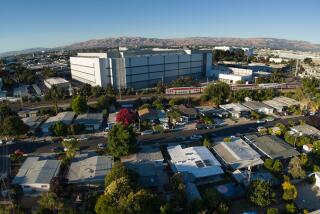Calpine to pump up its geothermal power source
Hoping to tap into California’s growing appetite for renewable power, Calpine Corp. today will unveil an ambitious expansion of its geothermal operations, considered one of the state’s most promising clean-energy sources.
The overhaul of the Geysers geothermal project, expected to cost $75 million in its first year, is evidence of the strong demand for cleaner energy in California. It is spurred by legislation aimed at reducing greenhouse gas emissions, which is pushing utilities to ramp up their use of energy from water, wind and sun.
Under goals set by the California Public Utilities Commission, Pacific Gas & Electric Co., Southern California Edison, San Diego Gas & Electric Co. and others must get 20% of their electricity from renewable sources by 2010.
In recent months, Edison signed the largest wind energy contract by a U.S. utility and agreed to a new, 10-year contract with Calpine for 225 megawatts of geothermal power from the Geysers. Calpine, one of the nation’s largest wholesale power sellers, also has a new, long-term contract to provide geothermal power to PG&E;, California’s largest electric utility.
“The Geysers has not seen a huge infusion of capital into it for many years ... but the market indicators are there to support investment and upgrades of the facilities,” Dennis Gilles, Calpine’s top geothermal executive, said in an interview last week. “You either have to have alternative-energy types being priced higher -- like the cost of natural gas -- or have a high demand for renewables. And we have both occurring right now.”
The Geysers expansion represents a departure for the San Jose-based power producer, which has been selling power plants and other assets since it fell into bankruptcy protection in late 2005. And it comes at a time when it is strapped for cash.
“I’m very excited and really proud of Calpine ... and I’m really encouraged that they’re taking the lead in such a critical area,” Public Utilities Commissioner Timothy A. Simon said Wednesday. “They’re a very vital part of the energy economy.”
Bernadette Del Chiaro, clean-energy advocate at advocacy group Environment California, said she applauded Calpine’s plans to draw more power from the Geysers, which naturally produces steam from hot rock formations deep underground.
“Geothermal is a terrific, clean, renewable resource that should be expanded,” she said. “It’s a no-brainer to tap into the immense energy that we have just under the earth. And it’s 24-7, it’s not intermittent, so it’s a crucial piece to have in the mix.”
Gilles, who has worked at the Geysers since 1987, said Calpine’s five-year expansion plan included drilling as many as 80 new wells, adding more water-injection systems to rejuvenate existing wells, and replacing or rebuilding steam turbines, cooling towers and generators on some of the existing power plants. The project would add as many as 80 megawatts to the current output of 725 megawatts and would breathe new life into plants that provide 147 megawatts.
The total tab is expected to be “well into the hundreds of millions of dollars,” Gilles said, but how the projects unfold will depend on getting approvals from Calpine creditors, as well as on the company’s ability to land long-term power contracts with utilities.
“The people we owe money to have to be convinced that spending money today on investments in existing facilities or on new development is in their best interest in the long haul,” Gilles said. “We have convinced them of some of it” already, he said, adding that he expected the argument for increased investments in the Geysers to strengthen as Calpine signs more contracts.
The Geysers is the world’s largest geothermal operation, boasting 21 power plants and 350 steam wells spread over 40 square miles in the Mayacamas Mountains, about 70 miles north of San Francisco. Calpine owns and operates 19 of the power plants; the other operator is the Northern California Power Agency.
The natural resource’s rich history began with its discovery in 1847 by a man who happened upon a steaming valley and named it the Geysers. The name stuck even though there were no true geysers in the area, only hot springs and steam coming from holes in the ground, called fumaroles, according to a history compiled by Calpine.
The Geysers was first developed as part of a spa called the Geysers Resort Hotel. Its first power plant was built in 1921, but the process wasn’t a commercial success until the 1950s. The resource was divvied up among many companies for decades, and Calpine began buying sites in 1989.
Calpine, founded in 1984, was among the most aggressive among a group of unregulated wholesale power providers that hoped to thrive amid a wave of deregulation in states such as California. The company bought and built natural gas-fired power plants but was saddled with too much debt to survive both high natural gas prices and the regulatory retrenchment that followed the Enron debacle.
The company’s bankruptcy filing led to a string of divestitures. On Wednesday, Calpine gave its creditors a draft reorganization plan intended to pave the way for its emergence from bankruptcy protection this year.
*
*
Begin text of infobox
Power producer
The company
Name: Calpine Corp.
Headquarters: San Jose
Founded: 1984
Bankruptcy filing: December 2005
Employees: 2,300
Holdings: 65 natural gas-fired power plants, plus 19 of the 21 geothermal power plants at the Geysers
Notable: Calpine is the nation’s largest geothermal producer.
The Geysers
Location: Steam fields cover 40 square miles of land in the Mayacamas Mountains, about 70 miles north of San Francisco.
Notable: The world’s largest single geothermal resource, with 21 power plants, 350 steam wells and 58 injection wells
First commercial steam well: 1954
Power generation: As much as 25% of California’s renewable energy. Calpine’s plants produce as many as 725 megawatts, enough to power 725,000 homes.
Technology: Wells drilled as deep as two miles below ground tap naturally occurring steam, which is brought to the surface, powering turbines and producing electricity. In some locations, Calpine injects wastewater to augment steam production.
*
Source: Calpine Corp.
More to Read
Inside the business of entertainment
The Wide Shot brings you news, analysis and insights on everything from streaming wars to production — and what it all means for the future.
You may occasionally receive promotional content from the Los Angeles Times.










